|
Pressure
Transducers - Installation and Use
INTRODUCTION
Common
problems or questions concerning the use of pressure transducers
are:
1.
Transducer outputs and their wiring configurations;
2. Wiring one transducer to multiple readouts, recorders, computers,
etc.;
3. Wiring multiple transducers to one readout, recorder, computer,
etc.;
4. Using a milliamp signal with voltage input instrumentation;
5. Determining how many transducers can be excited from one
power supply.
Each of these problems, or questions are discussed in detail in
the following article.
TRANSDUCER
OUTPUTS AND THEIR WIRING CONFIGURATIONS
OMEGA transducers have three main types of electrical outputs;
millivolts (mV), volts (V), and current (mA). It is important
for the user to know which output suits his application to ensure
proper selection of a transducer. The following will describe
the advantages, disadvantages, and wiring for millivolt, volt
and current output transducers.
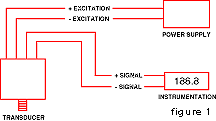 Transducers
with a millivolt output are generally used in laboratory applications.
They are low cost, small in size, and require a regulated power
supply. Remembering that the millivolt signal is very low level,
it is limited to short distances (up to 200 feet is usually considered
the limit) and is very prone to stray electrical interference
from other nearby electrical signals (other instrumentation, high
ac voltage lines, etc.). Typical wiring configurations are shown
in Transducers
with a millivolt output are generally used in laboratory applications.
They are low cost, small in size, and require a regulated power
supply. Remembering that the millivolt signal is very low level,
it is limited to short distances (up to 200 feet is usually considered
the limit) and is very prone to stray electrical interference
from other nearby electrical signals (other instrumentation, high
ac voltage lines, etc.). Typical wiring configurations are shown
in
Figure 1.
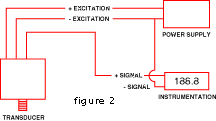 Transducers
with an amplified voltage output are generally used in a light
industrial environment and computer interface systems, where a
higher level dc signal is required. Due to the built-in signal
conditioning, they are higher cost and larger in size than the
millivolt output transducers. Amplified voltage signals can travel
up to medium distances and are much better in their immunity to
stray electrical interference than the millivolt signal. Typical
wiring configurations are shown in Figure 2. Transducers
with an amplified voltage output are generally used in a light
industrial environment and computer interface systems, where a
higher level dc signal is required. Due to the built-in signal
conditioning, they are higher cost and larger in size than the
millivolt output transducers. Amplified voltage signals can travel
up to medium distances and are much better in their immunity to
stray electrical interference than the millivolt signal. Typical
wiring configurations are shown in Figure 2.
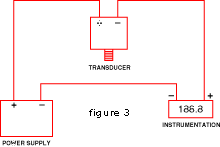 A
transducer produces millivolts, amplified voltage, or current
output. A transmitter produces current output only. Again, due
to the built-in signal conditioning, the transmitters are higher
cost and larger in size than the millivolt output transducers.
Unlike the millivolt and voltage output transducers, a current
signal is immune to any stray electrical interference, a valuable
asset in the factory. A current signal also can be transmitted
long distances. Typical wiring configurations are shown in Figure
3. A
transducer produces millivolts, amplified voltage, or current
output. A transmitter produces current output only. Again, due
to the built-in signal conditioning, the transmitters are higher
cost and larger in size than the millivolt output transducers.
Unlike the millivolt and voltage output transducers, a current
signal is immune to any stray electrical interference, a valuable
asset in the factory. A current signal also can be transmitted
long distances. Typical wiring configurations are shown in Figure
3.
WIRING
ONE TRANSDUCER TO MULTIPLE READOUTS, RECORDERS, COMPUTERS, ETC.
One
of the great advantages of a current signal is the simplicity
in setting up a multi-instrument system. Long distance transmission
from instrument to instrument without electrical interference
make multi-instrument systems easy. For example, a material test
center may have one control room for all the different test labs,
enabling operation from one central location. Instrument calibration
and troubleshooting are simple in a multi-instrument current loop.
The only limitation for the number of instruments is the amount
of voltage from the power supply driving the current loop. The
minimum voltage required is determined by Ohms law, V-IR (voltage
equals current times resistance). This is shown and explained
in Figure 4.
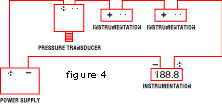 WHERE: WHERE:
RLINE
= resistance due to wire
RLOAD = combined instrumentation resistances
VsTRANSDUCER
= minimum supply voltage for transducer
For
example, let's assume you have the following:
1.
Pressure transmitter (4-20 mA) with 12-30 Vdc supply voltage;
2.
Panel meter with a 10 ohm input impedance;
3.
Recorder with a 25 ohm input impedance;
4.
Computer with a 200 ohm input impedance;
5.
Lead wire resistance of 5 ohms.
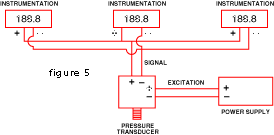 Minimum
voltage required = (.020). (5 + 10 + 25 + 200) + 12 = 16.8 volts
24 volts is the most common power supply in a 4-20 mA current
loop. Wiring a voltage or millivolt signal to multiple instruments
also can be done, but is not as easy and does not have the calibration
and troubleshooting advantages inherent in a current loop system.
The voltage or millivolt signal can be wired in parallel to multiple
instruments as shown in Figure 5. This method assumes a very high
input impedance in the instruments being wired. If this is not
the case, an analog output can be used instead to retransmit the
signal. Minimum
voltage required = (.020). (5 + 10 + 25 + 200) + 12 = 16.8 volts
24 volts is the most common power supply in a 4-20 mA current
loop. Wiring a voltage or millivolt signal to multiple instruments
also can be done, but is not as easy and does not have the calibration
and troubleshooting advantages inherent in a current loop system.
The voltage or millivolt signal can be wired in parallel to multiple
instruments as shown in Figure 5. This method assumes a very high
input impedance in the instruments being wired. If this is not
the case, an analog output can be used instead to retransmit the
signal.
WIRING
MULTIPLE TRANSDUCERS TO ONE READOUT, RECORDER, COMPUTER, ETC.
In
measuring multiple pressures, it is a common mistake trying to
use multiple transducers, a switching device, and just one panel
meter, thus saving money on multiple panel meters (or any other
instrumentation). The problem is that each transducer has a unique
zero point and the readout only has one zero screw. The net result
is that the total accuracy increases to about 3%, even though
each sensor is 0.5% accurate. In most cases, this larger error
is intolerable.
The
correct method of using multiple transducers with one readout
device is to use transducers that have built-in zero and span
adjustments screws, the same output (voltage or current), and
the same pressure range. Each transducer is adjusted by applying
a known pressure, so that they all have identical outputs. When
they all have identical outputs, the meter is scaled and a switch
can be used.
Another
solution to using multiple transducers with one readout is to
use a scanner instead of meter and a switch. There are many types
of scanners. The type of scanner that works with multiple pressure
transducers must have independent scaling on each channel.
Some
scanners, besides having independent scaling on each channel,
also offer independent current, voltage, or millivolt inputs to
each channel. These types of scanners enable you to use transducers
with different outputs as well as different pressure ranges with
the same instrument.
Figure
2. Typical wiring configuration for voltage output transducer
(-excitation
and -signal are common)
Figure
1. Typical wiring configuration for millivolt output transducer
Figure 3. Typical wiring configuration for current output transducer
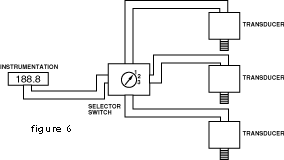 Figure
4. Multi-instrument 4-20mA current loop (panel meters, chart recorder,
computers, etc.) Figure
4. Multi-instrument 4-20mA current loop (panel meters, chart recorder,
computers, etc.)
Minimum
voltage req'd = (0.20 Amps)(R LINE + R LOAD) + Vs TRANSDUCER
Figure
5. Multiple instruments wired in parallel to a voltage output
transducer
USING A MILLIAMP SIGNAL WITH VOLTAGE INPUT INSTRUMENTATION
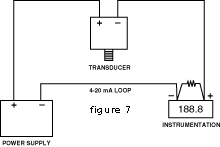 Most
instrumentation is set up to receive voltage. A commonly asked
question is how to use a current signal with instrumentation set
up for voltage. This is simply done by installing a resistor across
the input terminals of the instrumentation. The value of the resistor
is determined by Ohms law (V = IR). For example, installing a
500 ohm resistor will convert 20 mA to 10 volts (V = IR = .020
x 500). This is shown in Figure 7. The only other consideration
is the zero offset. Since most current loops have a low end of
4 mA, there will be a zero offset. Using the same value resistor
as above 4 mA will convert to 2 volts. Most
instrumentation is set up to receive voltage. A commonly asked
question is how to use a current signal with instrumentation set
up for voltage. This is simply done by installing a resistor across
the input terminals of the instrumentation. The value of the resistor
is determined by Ohms law (V = IR). For example, installing a
500 ohm resistor will convert 20 mA to 10 volts (V = IR = .020
x 500). This is shown in Figure 7. The only other consideration
is the zero offset. Since most current loops have a low end of
4 mA, there will be a zero offset. Using the same value resistor
as above 4 mA will convert to 2 volts.
R=V/I
Where: R = Size of Resistor
V = Desired Voltage
I = Current
Example:
To Convert 4-20 mA into 2-10 V
R = V/I = 10/.02 = 500 Ohms
A
500 Ohm Resistor Would be Installed Across the (+) and (-) Terminals
on the Instrumentation
DETERMINING
HOW MANY TRANSDUCERS CAN BE EXCITED FROM ONE POWER SUPPLY
Multiple
transducers can be excited from one power supply. The number of
transducers that can be used is simply determined by the current
draw of each transducer and the current capacity of the supply
source. The sum of the current draw of the transducers can not
exceed the total current capacity of the supply. For example,
if you have 50 transducers drawing 13 milliamps, you will need
a power supply having at least 650 milliamps (50 x 13). There
is also nothing wrong with powering just one transducer with a
power supply having high current capacity.
Figure
6. Multiple transducers wired to one meter and one switch (transducers
with built-in zero & span adjustments, same outputs & same pressure
ranges)
Figure
7. Converting current into voltage for instrumentation set up
for voltage
|
HANDLING,
LOCATING AND INSTALLING TRANSDUCERS
A.
Diaphragm - Do not press or touch the diaphragm as
you may damage or alter its calibration, particularly on
low pressure range models.
B.
Fittings and Hardware - Use appropriate pressure rated
fittings and hardware. Make sure you have the correct thread
type and size fitting. Use pressure limiters, capacity chambers,
snubbers, etc., if needed.
C.
Operate at Ambient Temperatures - Locate the transducer
where it can be readily inspected and serviced. Ambient
temperature should be within the transducer specifications.
The temperature coefficient effects on the overall accuracy
of the transducer can be minimized the closer the ambient
temperature is to 25°C. Avoid locations with excessive vibration.
D.
Installation - Installation should be made only by qualified
personnel familiar with safety practices and knowledgeable
with all industry accepted standard relating to pressure
systems.Transducer calibration and/or zero may shift if
it is over-torqued when installing. Check for a zero shift
after installing. When installing transducers, refer to
standard industry torque data for thread size and material
type .
|
|



 Transducers
with a millivolt output are generally used in laboratory applications.
They are low cost, small in size, and require a regulated power
supply. Remembering that the millivolt signal is very low level,
it is limited to short distances (up to 200 feet is usually considered
the limit) and is very prone to stray electrical interference
from other nearby electrical signals (other instrumentation, high
ac voltage lines, etc.). Typical wiring configurations are shown
in
Transducers
with a millivolt output are generally used in laboratory applications.
They are low cost, small in size, and require a regulated power
supply. Remembering that the millivolt signal is very low level,
it is limited to short distances (up to 200 feet is usually considered
the limit) and is very prone to stray electrical interference
from other nearby electrical signals (other instrumentation, high
ac voltage lines, etc.). Typical wiring configurations are shown
in  Transducers
with an amplified voltage output are generally used in a light
industrial environment and computer interface systems, where a
higher level dc signal is required. Due to the built-in signal
conditioning, they are higher cost and larger in size than the
millivolt output transducers. Amplified voltage signals can travel
up to medium distances and are much better in their immunity to
stray electrical interference than the millivolt signal. Typical
wiring configurations are shown in Figure 2.
Transducers
with an amplified voltage output are generally used in a light
industrial environment and computer interface systems, where a
higher level dc signal is required. Due to the built-in signal
conditioning, they are higher cost and larger in size than the
millivolt output transducers. Amplified voltage signals can travel
up to medium distances and are much better in their immunity to
stray electrical interference than the millivolt signal. Typical
wiring configurations are shown in Figure 2.  A
transducer produces millivolts, amplified voltage, or current
output. A transmitter produces current output only. Again, due
to the built-in signal conditioning, the transmitters are higher
cost and larger in size than the millivolt output transducers.
Unlike the millivolt and voltage output transducers, a current
signal is immune to any stray electrical interference, a valuable
asset in the factory. A current signal also can be transmitted
long distances. Typical wiring configurations are shown in Figure
3.
A
transducer produces millivolts, amplified voltage, or current
output. A transmitter produces current output only. Again, due
to the built-in signal conditioning, the transmitters are higher
cost and larger in size than the millivolt output transducers.
Unlike the millivolt and voltage output transducers, a current
signal is immune to any stray electrical interference, a valuable
asset in the factory. A current signal also can be transmitted
long distances. Typical wiring configurations are shown in Figure
3. WHERE:
WHERE:
 Minimum
voltage required = (.020). (5 + 10 + 25 + 200) + 12 = 16.8 volts
24 volts is the most common power supply in a 4-20 mA current
loop. Wiring a voltage or millivolt signal to multiple instruments
also can be done, but is not as easy and does not have the calibration
and troubleshooting advantages inherent in a current loop system.
The voltage or millivolt signal can be wired in parallel to multiple
instruments as shown in Figure 5. This method assumes a very high
input impedance in the instruments being wired. If this is not
the case, an analog output can be used instead to retransmit the
signal.
Minimum
voltage required = (.020). (5 + 10 + 25 + 200) + 12 = 16.8 volts
24 volts is the most common power supply in a 4-20 mA current
loop. Wiring a voltage or millivolt signal to multiple instruments
also can be done, but is not as easy and does not have the calibration
and troubleshooting advantages inherent in a current loop system.
The voltage or millivolt signal can be wired in parallel to multiple
instruments as shown in Figure 5. This method assumes a very high
input impedance in the instruments being wired. If this is not
the case, an analog output can be used instead to retransmit the
signal.  Figure
4. Multi-instrument 4-20mA current loop (panel meters, chart recorder,
computers, etc.)
Figure
4. Multi-instrument 4-20mA current loop (panel meters, chart recorder,
computers, etc.)  Most
instrumentation is set up to receive voltage. A commonly asked
question is how to use a current signal with instrumentation set
up for voltage. This is simply done by installing a resistor across
the input terminals of the instrumentation. The value of the resistor
is determined by Ohms law (V = IR). For example, installing a
500 ohm resistor will convert 20 mA to 10 volts (V = IR = .020
x 500). This is shown in Figure 7. The only other consideration
is the zero offset. Since most current loops have a low end of
4 mA, there will be a zero offset. Using the same value resistor
as above 4 mA will convert to 2 volts.
Most
instrumentation is set up to receive voltage. A commonly asked
question is how to use a current signal with instrumentation set
up for voltage. This is simply done by installing a resistor across
the input terminals of the instrumentation. The value of the resistor
is determined by Ohms law (V = IR). For example, installing a
500 ohm resistor will convert 20 mA to 10 volts (V = IR = .020
x 500). This is shown in Figure 7. The only other consideration
is the zero offset. Since most current loops have a low end of
4 mA, there will be a zero offset. Using the same value resistor
as above 4 mA will convert to 2 volts.